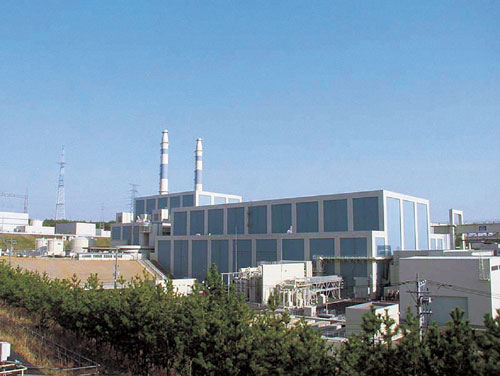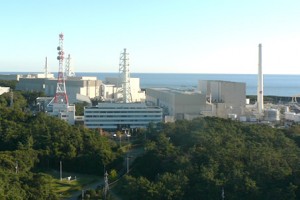Nuclear Energy Blog Carnival 223
 The 223rd edition of the Carnival of Nuclear Bloggers has been posted at Next Big Future. You can click here to access this latest post in a long running tradition among pro-nuclear authors and bloggers.
The 223rd edition of the Carnival of Nuclear Bloggers has been posted at Next Big Future. You can click here to access this latest post in a long running tradition among pro-nuclear authors and bloggers.

A message from NV5, Inc.
Seconds Matter: Rethinking Nuclear Facility Security for the Modern Threat Landscape
 The 223rd edition of the Carnival of Nuclear Bloggers has been posted at Next Big Future. You can click here to access this latest post in a long running tradition among pro-nuclear authors and bloggers.
The 223rd edition of the Carnival of Nuclear Bloggers has been posted at Next Big Future. You can click here to access this latest post in a long running tradition among pro-nuclear authors and bloggers.
Dr. Edward Calabrese recently published a paper titled The Genetics Panel of the NAS BEAR I Committee (1956): epistolary evidence suggests self‐interest may have prompted an exaggeration of radiation risks that led to the adoption of the LNT cancer risk assessment model.
For too long, graduate students have been inadvertently marginalized due to a lack of status recognition in the American Nuclear Society, but those days are now past. The ANS Board of Directors has unanimously approved the joint Student Sections Committee (SSC)/Young Members Group (YMG) proposal to offer free YMG membership to graduate students. This is a great day for all Young Members, regardless of whether they're still in graduate school or not.
The Environmental Protection Agency's proposed Clean Power Plan has gained favor with some nuclear energy advocates. An extensive analysis of the proposal, however, reveals that current nuclear generating capacity would largely suffer under the new carbon rules. In fact, the results of an evaluation performed by my fellow graduate student Justin Knowles and myself show that 15 states are actually incentivized to shut down all of their nuclear units and replace them with natural gas combined cycle (NGCC) generation. In effect, this plan allows for increasing carbon emissions; a far cry from the stated goals of the Clean Power Plan.
 In January, the U.S. Environmental Protection Agency issued an Advanced Notice of Proposed Rulemaking (ANPR) concerning 40 CFR 190-the regulations that govern public exposure and release of radioactive materials resulting from normal nuclear power plant operations (it does not pertain to nuclear accidents). The public comment period for the proposed rulemaking ended on August 3.
In January, the U.S. Environmental Protection Agency issued an Advanced Notice of Proposed Rulemaking (ANPR) concerning 40 CFR 190-the regulations that govern public exposure and release of radioactive materials resulting from normal nuclear power plant operations (it does not pertain to nuclear accidents). The public comment period for the proposed rulemaking ended on August 3.
 The 222nd edition of the Carnival of Nuclear Bloggers and Authors has been posted at Atomic Insights. You can click here to access the latest installment in a long running tradition among pro-nuclear authors and bloggers.
The 222nd edition of the Carnival of Nuclear Bloggers and Authors has been posted at Atomic Insights. You can click here to access the latest installment in a long running tradition among pro-nuclear authors and bloggers.
Got a minute (and 22 seconds)? Catch a quick update on the first new commercial nuclear energy in the United States of the 21st century-in Tennessee.

Shika NPP Unit 2. Courtesy Hokuriku Electric Power Co.
Yesterday, the saga of nuclear energy in post-Fukushima Japan reached an important milestone as the final utility that owns nuclear power plants in that country applied to the regulator for restart, in an event that snuck under the radar of most news venues.
 Vermont Yankee will go into decommissioning at the end of its current fuel cycle. The last day of operation for the nuclear plant is now set for December 29, 2014. Entergy, the owner, elected this course last year after financial analysis indicated the plant's unprofitability in a future of projected low natural gas prices.
Vermont Yankee will go into decommissioning at the end of its current fuel cycle. The last day of operation for the nuclear plant is now set for December 29, 2014. Entergy, the owner, elected this course last year after financial analysis indicated the plant's unprofitability in a future of projected low natural gas prices.
 It's time for the 221st edition of the Carnival of Nuclear Bloggers and Authors. This event circulates among the top pro-nuclear blogs, and each week highlights those items submitted to the host as most important or most timely. Of course, every week, there is a post made right here at ANS Nuclear Cafe to direct you to the Carnival - but on a rotating basis we host it here, and this week is one of those occasions. Let's go in!
It's time for the 221st edition of the Carnival of Nuclear Bloggers and Authors. This event circulates among the top pro-nuclear blogs, and each week highlights those items submitted to the host as most important or most timely. Of course, every week, there is a post made right here at ANS Nuclear Cafe to direct you to the Carnival - but on a rotating basis we host it here, and this week is one of those occasions. Let's go in!
Heavy lifts equal heavy progress at the construction site of V.C. Summer-2 and -3 in South Carolina. Following is the latest update on recent major milestones completed at what will be the first new commercial nuclear energy reactors in the United States in 30 years.
In April 2014, ANS Nuclear Cafe published a valuable historical account and analysis of the Three Mile Island accident titled TMI operators did what they were trained to do.
 The 220th edition of the Carnival of Nuclear Bloggers and Authors has been posted at Next Big Future. You can click here to access this latest installment of a long running tradition among pro-nuclear authors and bloggers.
The 220th edition of the Carnival of Nuclear Bloggers and Authors has been posted at Next Big Future. You can click here to access this latest installment of a long running tradition among pro-nuclear authors and bloggers.
 "I will see to it by some means or other. I will properly deal with it." So go the reported words of Japanese Prime Minister Shinzo Abe regarding the restart of nuclear power plants in Japan, as printed recently in the Japanese press. At the present time, while the Japanese government and courts seem to be at odds on restarting plants-with the public left in the middle-those at the nuclear plants themselves must count on eventual approval to restart and must ensure required measures are completed properly. Those preparing for restart continue to work toward that end while facing an improving, but not yet by any means certain, situation in the public and legal arenas.
"I will see to it by some means or other. I will properly deal with it." So go the reported words of Japanese Prime Minister Shinzo Abe regarding the restart of nuclear power plants in Japan, as printed recently in the Japanese press. At the present time, while the Japanese government and courts seem to be at odds on restarting plants-with the public left in the middle-those at the nuclear plants themselves must count on eventual approval to restart and must ensure required measures are completed properly. Those preparing for restart continue to work toward that end while facing an improving, but not yet by any means certain, situation in the public and legal arenas.
 The 219th edition of the Carnival of Nuclear Bloggers and Authors has been posted at The Hiroshima Syndrome. You can click here to access this latest installment of a long running tradition among pro-nuclear authors and bloggers.
The 219th edition of the Carnival of Nuclear Bloggers and Authors has been posted at The Hiroshima Syndrome. You can click here to access this latest installment of a long running tradition among pro-nuclear authors and bloggers.
If a tornado just happens to come through... flying steel pipes, telephone poles, or even automobiles will be no match for this building. This is the new Watts Bar FLEX building, housing emergency backup equipment like generators and pumps that could be used to replace equipment in case of damage from a natural disaster. Watts Bar will likely be the first nuclear facility in the United States to comply with all the Nuclear Regulatory Commission's post-Fukushima requirements, as the Tennessee Valley Authority works toward licensing for Watts Bar Unit 2 with a target date of beginning commercial operation in December next year.
The process for renewing research and test reactor (RTR) licenses in the United States has been subject to lengthy delays and periodic backlogs since the early 1980s. Despite the apparent time invested in improvement efforts, the process does not seem to be getting better very fast. The difficulty, schedule uncertainty, and cost of renewing research reactor licenses adds to the burden of owning and operating research reactors. The scale of the challenge may contribute to regrettable institutional decisions that maintaining operable facilities is not worth the trouble.
 The 218th Nuclear Energy Blog Carnival has been posted at Yes Vermont Yankee. You can click here to access this latest installment in a long running tradition among pro-nuclear authors and bloggers.
The 218th Nuclear Energy Blog Carnival has been posted at Yes Vermont Yankee. You can click here to access this latest installment in a long running tradition among pro-nuclear authors and bloggers.
 With cap-and-trade and carbon tax proposals going nowhere in congress, the Obama administration is tackling the global warming issue through the administrative branch, using U.S. Environmental Protection Agency regulations. In the transport sector, the administration promulgated vehicle fuel efficiency (mileage) standards. In the power sector, the EPA has proposed regulations requiring that all new power plants emit no more CO2 than a typical natural gas plant-thus, any new coal plants would have to employ CO2 sequestration. And now, the EPA is proposing to address CO2 emissions from existing power plants by establishing CO2 emissions reduction requirements for the power sector.
With cap-and-trade and carbon tax proposals going nowhere in congress, the Obama administration is tackling the global warming issue through the administrative branch, using U.S. Environmental Protection Agency regulations. In the transport sector, the administration promulgated vehicle fuel efficiency (mileage) standards. In the power sector, the EPA has proposed regulations requiring that all new power plants emit no more CO2 than a typical natural gas plant-thus, any new coal plants would have to employ CO2 sequestration. And now, the EPA is proposing to address CO2 emissions from existing power plants by establishing CO2 emissions reduction requirements for the power sector.
Ratepayers in the Pacific Northwest have reason to celebrate the dedicated employees of Energy Northwest's 1170-megawatt Columbia Generating Station: The Northwest's sole nuclear energy facility generated a record 9.7 million megawatt hours of electricity during the fiscal year that ended Monday, June 30-eclipsing a previous record of 9.5 million megawatt hours in fiscal year 2006.